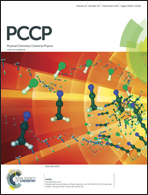Defect engineering in ZnO nanocones for visible photoconductivity and nonlinear absorption†
Abstract
Nanostructured ZnO is a promising material for optoelectronic and nonlinear optical applications because of the flexibility of band gap engineering by means of various defect states present in it. Employing the time-correlated single photon counting photoluminescence technique, the correlation between defect levels and optoelectronic and nonlinear optical properties of ZnO is explored in this work. By a facile solution method, ZnO nanocones with a dominating preferential orientation along energetically less favorable, oxygen terminated (10![[1 with combining macron]](https://www.rsc.org/images/entities/char_0031_0304.gif) 1) facets were synthesized using a passivating capping agent. Photoluminescence spectra demonstrate that the as-grown samples have both oxygen and zinc vacancies, and after calcination in air oxygen vacancies vanish, but zinc vacancies are enhanced. Photoconductivity of the samples reduces significantly upon calcination, confirming the reduction in oxygen vacancies. However, the samples exhibit a significant enhancement in the nonlinear optical absorption coefficient upon calcination, indicating that the effective two-photon absorption causing the nonlinear optical behaviour originates from zinc vacancies. These results illustrate the vast possibilities of band gap engineering in intrinsic ZnO for future optoelectronic applications.
1) facets were synthesized using a passivating capping agent. Photoluminescence spectra demonstrate that the as-grown samples have both oxygen and zinc vacancies, and after calcination in air oxygen vacancies vanish, but zinc vacancies are enhanced. Photoconductivity of the samples reduces significantly upon calcination, confirming the reduction in oxygen vacancies. However, the samples exhibit a significant enhancement in the nonlinear optical absorption coefficient upon calcination, indicating that the effective two-photon absorption causing the nonlinear optical behaviour originates from zinc vacancies. These results illustrate the vast possibilities of band gap engineering in intrinsic ZnO for future optoelectronic applications.



 Please wait while we load your content...
Please wait while we load your content...